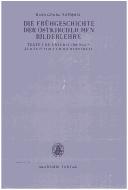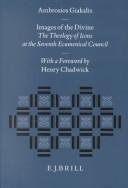| Listing 1 - 7 of 7 |
Sort by
|
Book
Abstract | Keywords | Export | Availability | Bookmark
 Loading...
Loading...Choose an application
- Reference Manager
- EndNote
- RefWorks (Direct export to RefWorks)
Book
ISBN: 9782503545967 2503545963 Year: 2012 Volume: 25 Publisher: Turnhout : Brepols Publishers,
Abstract | Keywords | Export | Availability | Bookmark
 Loading...
Loading...Choose an application
- Reference Manager
- EndNote
- RefWorks (Direct export to RefWorks)
Rather than as a destructive moment in history, the Iconoclasm of 1566 in the Netherlands was the catalyst for a re-evaluation of (religious) art in the Low Countries. It forced painters to question the very nature of the artistic tradition they grew up in. Is it merely a coincidence that the art markets changed so swiftly after the Fall of Antwerp, that art theory in the Low Countries originated in the wake of Iconoclasm (De Heere, Lampsonius, ...), or that painting in the second half of the sixteenth century saw the impetus of new styles, genres, specialisations (Aertsen, De Beuckelaer, ...)? Iconoclasm forced people to think about art. The generation of painters active in the two decades between the 'Beeldenstorm' and the fall of Antwerp did this by questioning the decorum of the work of their famous predecessors.
Painting --- anno 1500-1599 --- Netherlands --- Arts and religion --- Arts et religion --- Beeldenstorm en beeldenstrijd --- Beeldenstrijd -- Geschiedenis --- Beeldenstrijd en beeldenstorm --- Godsdienst en kunsten --- Iconoclasm --- Iconoclasm -- History --- Iconoclasme --- Iconoclasme -- Histoire --- Iconoclasme et iconoclastie --- Iconoclastie et iconoclasme --- Images [Querelle des ] --- Kunsten en godsdienst --- Querelle des Images --- Religion and arts --- Religion et arts --- Painting, Dutch --- Peinture hollandaise --- Painting, Netherlandish. --- History --- 16th century
Book
ISBN: 9789491436062 Year: 2016 Publisher: Izegem iD
Abstract | Keywords | Export | Availability | Bookmark
 Loading...
Loading...Choose an application
- Reference Manager
- EndNote
- RefWorks (Direct export to RefWorks)
History of the Low Countries --- anno 1500-1599 --- Beeldenstorm en beeldenstrijd --- Beeldenstrijd -- Geschiedenis --- Beeldenstrijd en beeldenstorm --- Iconoclasm --- Iconoclasm -- History --- Iconoclasme --- Iconoclasme -- Histoire --- Iconoclasme et iconoclastie --- Iconoclastie et iconoclasme --- Images [Querelle des ] --- Querelle des Images --- C1 --- kerkgeschiedenis --- protestantisme --- nieuwe tijd (x) --- biografie --- Kerken en religie --- History --- Biography --- 16th century
Book
ISBN: 9782874570667 2874570664 Year: 2013 Volume: 5 Publisher: Bruxelles Safran
Abstract | Keywords | Export | Availability | Bookmark
 Loading...
Loading...Choose an application
- Reference Manager
- EndNote
- RefWorks (Direct export to RefWorks)
Personne ne peut prétendre connaître Byzance ou son histoire et ignorer la Chronique de Théophane. Cet ouvrage constitue pour l’historiographie byzantine le point de passage d’un temps historique « avant Théophane » à un temps « après Théophane ». Sa popularité est en outre manifeste du fait qu’elle servait de livre scolaire, même pour les princes, pour l’apprentissage de l’Histoire. Le fait qu’Anastase le Bibliothécaire l’a choisi pour le traduire en latin, est la preuve irréfutable de l’autorité scientifique de la Chronique dans le monde occidental. Or, il faut être un spécialiste pour apprécier le débat acharné autour du rôle de Théophane à la composition de cet ouvrage transmis sous son nom. Cette question, qui tourmente la recherche historique depuis de Xe siècle, ne peut toutefois pas être dissociée de l’étude de la personnalité, toujours énigmatique, de Théophane. Qui était alors Théophane ? Qui était cet homme, né dans un milieu iconoclaste, qui a terminé sa vie comme confesseur de la cause des icônes ? Cet homme, né dans l’opulence, qui après un mariage de raison, prit l’habit monastique et passa sa vie comme un humble moine ? Comment, de cet homme ordinaire, le parti iconophile a créé un héros de la cause des icônes ? Et pourquoi, au Xe siècle Constantin, VII le Porphyrogénète et la propagande du Palais ont voulu propager la légende de Théophane ancêtre impérial et saint officiel de la cour ?
Beeldenstorm en beeldenstrijd --- Beeldenstrijd -- Geschiedenis --- Beeldenstrijd en beeldenstorm --- Iconoclasm --- Iconoclasm -- History --- Iconoclasme --- Iconoclasme -- Histoire --- Iconoclasme et iconoclastie --- Iconoclastie et iconoclasme --- Images [Querelle des ] --- Querelle des Images --- Theophanes, --- History and criticism --- Byzantine Empire --- History --- Theophanes the Confessor --- Theophanes continuatus --- Sources --- Theophanes conf. Sigrianae chronographus --- Theophanes, - the Confessor, - -approximately 818 --- Theophanes, - the Confessor, - -approximately 818 - Chronographia - History and criticism --- Byzantine Empire - History - Isaurian dynasty, 717-811 - Sources --- Theophanes, - the Confessor, - -approximately 818 - Chronographia
Book
ISBN: 3770530527 Year: 1995 Publisher: München Wilhelm Fink
Abstract | Keywords | Export | Availability | Bookmark
 Loading...
Loading...Choose an application
- Reference Manager
- EndNote
- RefWorks (Direct export to RefWorks)
iconoclasm --- History of civilization --- beeldenstorm --- Iconography --- Christian church history --- anno 1400-1499 --- anno 1500-1599 --- Beeldenstorm en beeldenstrijd --- Beeldenstrijd -- Geschiedenis --- Beeldenstrijd en beeldenstorm --- Iconoclasm --- Iconoclasm -- History --- Iconoclasme --- Iconoclasme -- Histoire --- Iconoclasme et iconoclastie --- Iconoclastie et iconoclasme --- Images [Querelle des ] --- Querelle des Images --- Reformation. --- Réforme (Christianisme) --- 246.3 --- -Iconoclasm --- -Reformation --- -#GROL:SEMI-27<43> '14/15' --- Protestant Reformation --- Reformation --- Counter-Reformation --- Protestantism --- Idols and images --- Beelden in kerken. Beeldenverering. Iconoclasme --- Worship --- Council of Europe countries --- Eastern Hemisphere --- Eurasia --- -246.3 --- -Europe --- 246.3 Beelden in kerken. Beeldenverering. Iconoclasme --- Réforme (Christianisme) --- #GROL:SEMI-27<43> '14/15' --- Church history --- History --- Europe

ISBN: 3050008288 9783050008288 Year: 1992 Volume: Bd. 139 Publisher: Berlin Akademie Verlag
Abstract | Keywords | Export | Availability | Bookmark
 Loading...
Loading...Choose an application
- Reference Manager
- EndNote
- RefWorks (Direct export to RefWorks)
Beeldenstorm en beeldenstrijd --- Beeldenstrijd -- Geschiedenis --- Beeldenstrijd en beeldenstorm --- Iconoclasm --- Iconoclasm -- History --- Iconoclasme --- Iconoclasme -- Histoire --- Iconoclasme et iconoclastie --- Iconoclastie et iconoclasme --- Images [Querelle des ] --- Querelle des Images --- Icons --- Christianity and art --- Icônes --- Christianisme et art --- Sources. --- Cult --- History --- Orthodox Eastern Church --- Sources --- Culte --- Histoire --- Eglise orthodoxe --- 246.3 --- -Icons --- -Christianity and art --- -Art and Christianity --- Art --- Eikons --- Ikons --- Christian art and symbolism --- Christian saints in art --- Idols and images --- Beelden in kerken. Beeldenverering. Iconoclasme --- -History --- -Sources --- -Dictionaries --- -German --- Worship --- -Beelden in kerken. Beeldenverering. Iconoclasme --- 246.3 Beelden in kerken. Beeldenverering. Iconoclasme --- -246.3 Beelden in kerken. Beeldenverering. Iconoclasme --- Art and Christianity --- Icônes --- Orthodox Eastern Church&delete& --- History&delete& --- Cult&delete& --- History of doctrines --- Iconoclasm - Sources --- Icons - Cult - History - Sources --- Christianity and art - Orthodox Eastern Church - History - Sources

ISBN: 9004099468 9004474455 9789004099463 9789004474451 Year: 1993 Volume: 54 Publisher: Leiden New York E. J. Brill,
Abstract | Keywords | Export | Availability | Bookmark
 Loading...
Loading...Choose an application
- Reference Manager
- EndNote
- RefWorks (Direct export to RefWorks)
This book examines the theology of icons in the eighth century, the most critical period in the evolution of the Eastern Church's teaching on images. The principal source is provided by the acta of the Seventh Ecumenical Council of 787. The political circumstances which led to the outbreak of the controversy over icons are discussed in detail but the main emphasis is on the theological arguments and presuppositions of the participants in the council. Major themes include the nature of tradition, the relationship between image and reality and the place of christology. Ultimately the argument over icons was about the accessibility of the divine. Icons were held by the iconophiles to communicate a deifying grace which raised the believer to participation in the life of God.
Beeldenstorm en beeldenstrijd --- Beeldenstrijd -- Geschiedenis --- Beeldenstrijd en beeldenstorm --- Concile de Nicée (2ième : 787) --- Concilie van Nicaea (2de: 787) --- Council of Nicaea (2nd : 787) --- Iconoclasm --- Iconoclasm -- History --- Iconoclasme --- Iconoclasme -- Histoire --- Iconoclasme et iconoclastie --- Iconoclastie et iconoclasme --- Images [Querelle des ] --- Querelle des Images --- Council of Nicaea, --- 246.3 --- -Iconoclasm --- Beelden in kerken. Beeldenverering. Iconoclasme --- Council of Nicaea, 2nd, 787 --- -Orthodox Eastern Church --- 246.3 Beelden in kerken. Beeldenverering. Iconoclasme --- Icons --- Image (Theology) --- 262.5*17 --- Idols and images --- Christian art and symbolism --- Communication --- Eikons --- Ikons --- Christian saints in art --- 262.5*17 Nicea II--(787) --- Nicea II--(787) --- Cult --- History of doctrines --- History --- Worship --- Religious aspects --- Christianity --- Orthodox Eastern Church --- Doctrines. --- Council of Nicaea --- Concilio niceno --- Convegno niceno --- Konzil von Nizäa --- Doctrines --- Middle Ages, 600-1500 --- Council of Nicaea - (2nd : - 787) --- Icons - Cult - History of doctrines - Middle Ages, 600-1500. --- Image (Theology) - History of doctrines - Middle Ages, 600-1500. --- Middle Ages, 500-1500 --- Image (Theology) - History of doctrines - Middle Ages, 600-1500 --- Icons - Cult - History of doctrines - Middle Ages, 600-1500
| Listing 1 - 7 of 7 |
Sort by
|

 Search
Search Feedback
Feedback About UniCat
About UniCat  Help
Help News
News